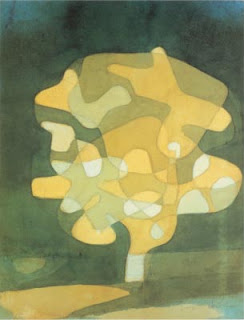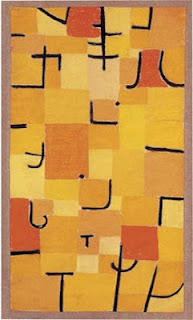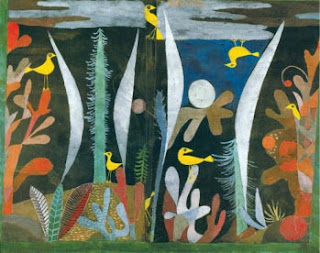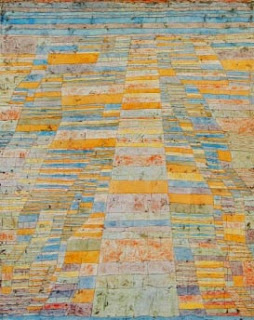***
Food painting artwork
30 x 30cm oil on marine ply panel - no framing required. A surreal sight floating past on a summers day.Original painting on your wall.
Find out what this painting would look like on your wall before buying. Email me a photo of your space and I'll Photoshop it into size and place to help you decide if it's right for you.Original artwork can be purchased in the Official Art Store. This particular piece is dry and available right now for $AU150. Email me (fi at wherefishsing dot com) to express your interest.
***
The recipe
Once upon a time I lived in a shared rented house with a friend whose recreation mostly consisted of drinking and whose friends were probably alcoholics. I was a student and seeing these guys drink a slab of beer each on the weekend and hearing about them getting their name engraved on the bar for some drinking feat or other was just normal. This particular house had a lemon tree in the backyard. One weekend, I'm telling the tale of how I had just chased some kid who was collecting lemons without asking, over the six foot fence and out of the yard. I would have said yes had he bothered with common courtesty and helped him gather them, but just hopping over the fence was outrageous to me. My friend becomes all fired up about the overload of lemons on the tree, and excitedly asks the little group of his drinking buddies and I, 'What do you do with loads of lemons?'. We all look at each other and say together, 'Tequila!'. Cue shocked expression and pure disappointment from our alcohol friendly questioner, 'Nooooo, LEMON MERIGUE PIE!!!!'.LMP is one of those recipes that is far more susceptable than most to the experience and knack of the cook. Recipes are only ever guides or roadmaps due to variations in oven and stove temperatures, ambient temperatures, seasonality of the ingredients, the size and material of the cooking pot (and some might say which way the wind is blowing and what the cook ate for breakfast). Unfortunately this dish is renowned as a tricky one and for good reason. Your familiarity with your stove and oven will be tested and the more meringues you have whipped the better you will be at gauging when the foam is ready to cook. Rest assured, that no matter how many times you have to practice this to get it spot on, the tests that might look a little wonky will taste great.
1 pre-baked short crust pastry case of 9" diameter - the pastry needs to be cooked before the filling is added as there is not enough baking time or heat to cook it once the pie is assembled and in the oven.
4 tablespoons arrowroot / tapioca flour - use arrowroot instead of cornflour as it is stronger, has less taste and is transparent instead of cloudy.
3/4 cup / 180ml water
1/3 cup / 60g butter
1 cup sugar or more to taste
5 eggs, separated into yolks and whites - room temperature eggs are best as they whip up into meringue faster than cold ones. Also fresh eggs make a smaller but stable foam, while older ones (more than 3-4 days) make a large unstable foam. Take your pick.
3 medium sized lemons - you need all the zest and juice. Handy hint - zest first!
10 tablespoons castor sugar for the meringue - use castor sugar as it is a small sized grain and dissolves quickly into the meringue. Less sugar can be used but the meringue will be correspondingly less stable.
2 1/2 teaspoons cornflour or arrowroot - a tiny bit of this in the meringue traps moisture and reduces beading.
rounded 1/4 teaspoon cream of tartar - this strengthens the meringue foam and reduces the amount of shrinking.
Pre-bake (bake blind) your pastry case and leave it in the baking tin.
Get/leave the oven on so it will be at 190C /325F when the pie is assembled.
For the lemon filling:
In a pot, blend the arrowroot and water.
Add the cup of sugar, egg YOLKS only, and the lemon zest and juice and mix together. A small whisk is really handy for this. Make sure the the yolks are well mixed in before the next step or you end up with eggy threads throughout the lemon filling (harmless but odd).
Then put the butter in the pot and begin heating. Once you start heating this mix do not pause or stop or it will not set. Stir frequently.
As soon as most of the sugar has dissolved, taste and add more sugar to this mix if you prefer it sweeter. I like this quite tart as the meringue is quite sweet.
Now, heat, stirring constantly, until the mixture boils. Again, a small whisk is ideal for the stirring.
Turn the heat down to medium and keep stirring while the mix cooks for one minute. It should become impossibly thick.
Take it off the heat and let it cool slightly for a few minutes, then pour the mix into the pre-baked pastry case.
To make the meringue topping:
Combine the castor sugar, cornflour/arrowroot and cream of tartar.
In a scrupulously clean bowl (no oil or fats allowed or your egg whites just won't whip up into fluffy heaven), beat the egg whites into a coarse foam.
Once you start whipping the whites, do not pause or stop.
Now begin adding the sugar mix, one tablespoon at a time. Don't start with the sugar in with the whites or the whipping time will be doubled.
Cautiously add the sugar because if it's added too quickly it won't dissolve. A tablespoon at a time, whip until mostly dissolved, then add more. Rubbing the meringue between two fingers will tell you how much the sugar has dissolved. You can feel the grains.
Finally, whip the egg whites until they are stiff. You know they are stiff when you can make little mountains (peaks) and they stay standing up with no flopping over of their tips. Or when an upsidedown spoonful stays on the spoon. Or when tracks spooned through the meringue stay put indefinately. If the meringue starts to lose it's gloss while you are whipping, stop! That is the sign of over whipping.
When the meringue is ready - pile it on top of the hot lemon mix in the pastry case. The heat of the filling helps cook the meringue from the bottom and a properly cooked meringue does not weep and form a pool of liquid on top of the lemon filling leading to the meringue sliding off the lemon.
Also make sure the filling is entirely covered and the pastry meets the meringue all the way round to make a complete seal. This helps to stop the meringue shrinking.
Bake immediately to set the meringue at 190C for 25 minutes or until the meringue on top has browned lightly. A long baking at a low temperature means the meringue will hold up better, though all meringue will shrink a bit.
Resist eating instantly - LET THE PIE COOL FOR AT LEAST THREE HOURS, PREFERABLY FOUR, BEFORE CUTTING INTO IT OR ALL YOU WILL GET IS RUNAWAY LEMON SLUDGE. I know from sad experience.
Makes enough for you to be decadent with 5-7 friends.
3/4 cup / 180ml water
1/3 cup / 60g butter
1 cup sugar or more to taste
5 eggs, separated into yolks and whites - room temperature eggs are best as they whip up into meringue faster than cold ones. Also fresh eggs make a smaller but stable foam, while older ones (more than 3-4 days) make a large unstable foam. Take your pick.
3 medium sized lemons - you need all the zest and juice. Handy hint - zest first!
10 tablespoons castor sugar for the meringue - use castor sugar as it is a small sized grain and dissolves quickly into the meringue. Less sugar can be used but the meringue will be correspondingly less stable.
2 1/2 teaspoons cornflour or arrowroot - a tiny bit of this in the meringue traps moisture and reduces beading.
rounded 1/4 teaspoon cream of tartar - this strengthens the meringue foam and reduces the amount of shrinking.
Pre-bake (bake blind) your pastry case and leave it in the baking tin.
Get/leave the oven on so it will be at 190C /325F when the pie is assembled.
For the lemon filling:
In a pot, blend the arrowroot and water.
Add the cup of sugar, egg YOLKS only, and the lemon zest and juice and mix together. A small whisk is really handy for this. Make sure the the yolks are well mixed in before the next step or you end up with eggy threads throughout the lemon filling (harmless but odd).
Then put the butter in the pot and begin heating. Once you start heating this mix do not pause or stop or it will not set. Stir frequently.
As soon as most of the sugar has dissolved, taste and add more sugar to this mix if you prefer it sweeter. I like this quite tart as the meringue is quite sweet.
Now, heat, stirring constantly, until the mixture boils. Again, a small whisk is ideal for the stirring.
Turn the heat down to medium and keep stirring while the mix cooks for one minute. It should become impossibly thick.
Take it off the heat and let it cool slightly for a few minutes, then pour the mix into the pre-baked pastry case.
To make the meringue topping:
Combine the castor sugar, cornflour/arrowroot and cream of tartar.
In a scrupulously clean bowl (no oil or fats allowed or your egg whites just won't whip up into fluffy heaven), beat the egg whites into a coarse foam.
Once you start whipping the whites, do not pause or stop.
Now begin adding the sugar mix, one tablespoon at a time. Don't start with the sugar in with the whites or the whipping time will be doubled.
Cautiously add the sugar because if it's added too quickly it won't dissolve. A tablespoon at a time, whip until mostly dissolved, then add more. Rubbing the meringue between two fingers will tell you how much the sugar has dissolved. You can feel the grains.
Finally, whip the egg whites until they are stiff. You know they are stiff when you can make little mountains (peaks) and they stay standing up with no flopping over of their tips. Or when an upsidedown spoonful stays on the spoon. Or when tracks spooned through the meringue stay put indefinately. If the meringue starts to lose it's gloss while you are whipping, stop! That is the sign of over whipping.
When the meringue is ready - pile it on top of the hot lemon mix in the pastry case. The heat of the filling helps cook the meringue from the bottom and a properly cooked meringue does not weep and form a pool of liquid on top of the lemon filling leading to the meringue sliding off the lemon.
Also make sure the filling is entirely covered and the pastry meets the meringue all the way round to make a complete seal. This helps to stop the meringue shrinking.
Bake immediately to set the meringue at 190C for 25 minutes or until the meringue on top has browned lightly. A long baking at a low temperature means the meringue will hold up better, though all meringue will shrink a bit.
Resist eating instantly - LET THE PIE COOL FOR AT LEAST THREE HOURS, PREFERABLY FOUR, BEFORE CUTTING INTO IT OR ALL YOU WILL GET IS RUNAWAY LEMON SLUDGE. I know from sad experience.
Makes enough for you to be decadent with 5-7 friends.
+++
More vegetarian cookbook goodies
Need help with cooking conversions? Download this handy dandy pdf of cooking conversion charts for every cooking measuring system I could find. It should make your life easier.
Where are the rest of the vegetarian dinner recipes? They're all in the Table of Contents.
+++
Volunteering.
One of the most dislocating aspects of moving to a new place is not knowing anyone. One of the best ways I've found to solve this alienation is to arrive and immediately volunteer in the community. There is nothing like throwing yourself in to helping out to help you meet people and get to know your new area. It's win win for everyone.
This morning I've spent doing the morning shift looking after the community gallery here in my new town of Bellingen. It's been quite a pleasant learning.
Artist inspiration and artist influences. No biographies, dates or scholarly research here - this is a personal response to the work of Paul Klee by Australian artist Fiona Morgan.
 |
| Twittering Machine - possible my all time favourite painting |
 |
| Ad Marginem |
 |
| Ancient Harmony |
 |
| Fig Tree |
 |
| Good Place For Fish |
 |
| The Mountain of the Sacred Cat |
 |
| Polyphon Gefasstes Weiss |
 |
| Ripe Harvest |
 |
| Signes En Jaune |
 |
| Paukenspiele |
More Paul Klee paintings
 |
| A Childrens Game |
 |
| Composition |
 |
| Bird Garden |
 |
| Abenteur Schiff |
 |
| Abstract Composition of Houses |
 |
| Ad Parnassum |
 |
| Analysis of Diverse Perversities |
 |
| Around The Kernel |
 |
| Castle Garden |
 |
| Castle and Sun |
 |
| Cat and Bird |
 |
| Fire in the Evening |
 |
| Fish Magic |
 |
| Flora di Roccia |
 |
| Flower Myth |
 |
| Fruchte Auf Rot |
 |
| Gedanken Bei Schnee |
 |
| Heroic Strokes of the Bow |
 |
| Homes Of The Tree |
 |
| Im Bachschen Stil |
 |
| Insula Dulcamara |
 |
| La Belle Jardiniere |
 |
| Lady Apart |
 |
| Landscape with Yellow Birds |
 |
| Main Lane and Side Lanes |
 |
| Mask of Fear |
 |
| Orpheus |
 |
| Pastoral (rhythms) |
 |
| Picture Album |
 |
| Red Balloon |
 |
| Rose Garden |
 |
| Rote Weste |
 |
| Scheidung Abends |
 |
| Senecio |
 |
| Sinbad the Sailor |
 |
| The Golden Fish |
 |
| Three Houses and a Bridge |
 |
| Cathedrals |
More Paul Klee links
Paul Klee Centre http://www.zpk.org/http://en.wikipedia.org/wiki/Paul_Klee
About the Creative Cauldron series of posts
The rest of the series is accessible via the Creative Cauldron page. Have a meander if you please, and remember to check out my artworks on Flickr, and have an insider peek at life as an artist on Facebook.











